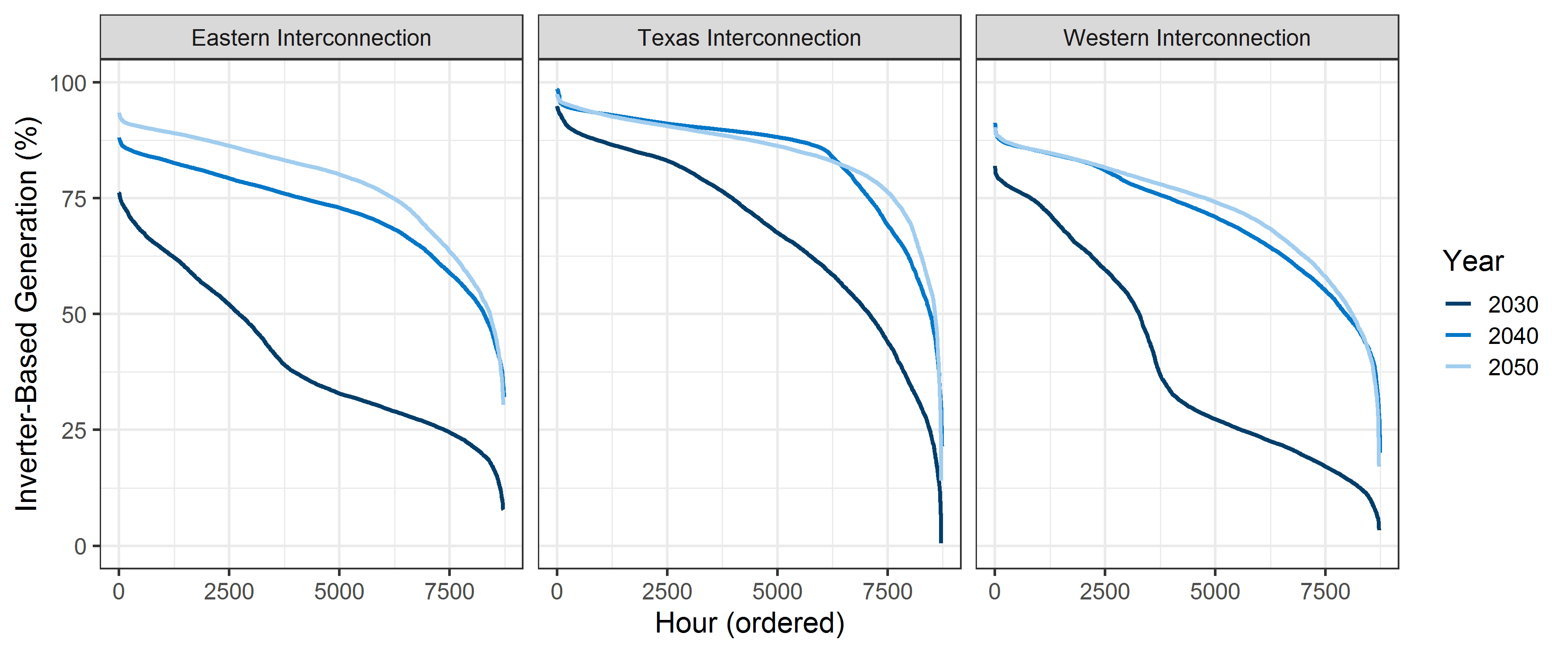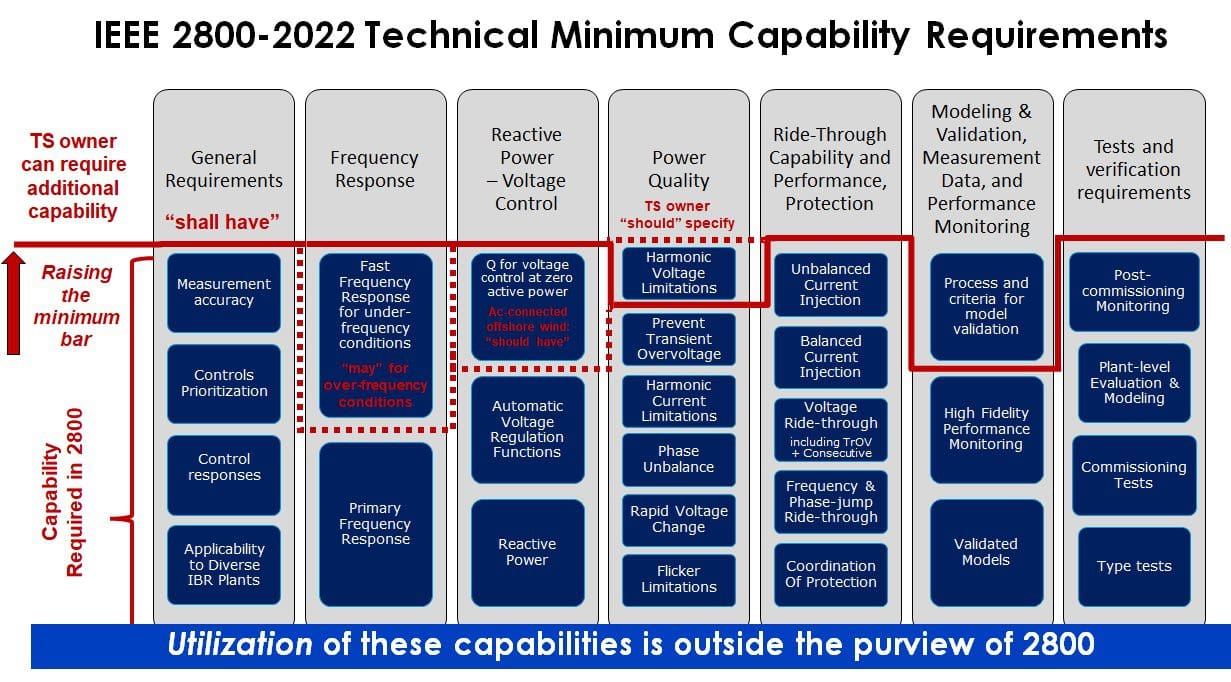The trend to connect large-scale wind, solar, battery and other inverter-based resources (IBRs) to the electric power grid is accelerating. The U.S. Department of Energy estimates that solar power alone, for example, could account for as much as 40% of the nation’s annual electricity generation by 2035, although the penetration of IBRs at certain times of the day may approach 100% of instantaneous load.

Image source: U.S. Department of Energy’s Solar Futures Study, produced by the National Renewable Energy Laboratory
While these renewable (often variable) energy resources offer important environmental and economic benefits, they also can impact the reliability of the bulk power grid. Because the inverters which connect them to the grid are based on semiconductor technology, not traditional power plant technology. They operate differently than rotating machines with different characteristics. With IBRs we can go beyond the characteristics of synchronous machines, and have a broader spectrum of programmable options to make the grid work even better.
Thus, the increasing penetration of IBRs could potentially change the very nature of the grid’s dynamic performance as their sizes and numbers grow. Whether this helps or harms future electric system reliability depends on the choices we make today, as the IBR plants that connect today will operate for decades to come.
To advance grid stability and reliability in the near- and long-term, IEEE Standards Association (IEEE SA) has recently published a new standard, IEEE 2800™–2022, Standard for Interconnection and Interoperability of Inverter-Based Resources (IBR) Interconnecting with Associated Transmission Electric Power Systems.
IEEE 2800 establishes a uniform set of technical minimum requirements for the interconnection, capability, and performance of IBRs interconnecting with electrical transmission and sub-transmission systems. The specified requirements are intended to apply over the entire lifetime of the IBR plant. Conformity to the requirements should be verified prior to commissioning and in periodic intervals after commissioning.
Recent System Disturbances Highlight the Need for IEEE 2800
The new standard is highly needed, as evidenced by several NERC reports over the past few years which found that a number of IBRs responded to system events inappropriately, resulting in significant system disturbances:
- In May, 2021 some 1,340 MW of power, enough for more than 40,000 homes, was lost in the Odessa Disturbance, stemming from a transformer malfunction at a combined-cycle power plant near Odessa, Texas. The transformer fault was quickly cleared but it led to voltage disturbances on the power grid as far as 200 miles away, and while the transmission system in that area recovered quickly, power from the combined cycle plant plus about ten times as much total power from other solar and wind IBR plants in that area was lost nonetheless.
- About 1,000 MW of solar output was lost during the San Fernando Disturbance in southern California in July 2020, following a three-phase fault stemming from an issue on a transmission tower.
- The Blue Cut wildfire in southern California in 2016 caused some brief electrical faults that resulted in the sudden unnecessary loss of about 1,200 MW of solar generation.
While the technical analyses in these disturbance reports suggest a range of issues regarding IBR performance, the underlying cause of these issues is two-fold:
- The lack of uniform minimum technical interconnection requirements for bulk-system-connected IBR plants creates meaningful ambiguities that result in inconsistent IBR implementations, which can lead to a lack of the capability needed to ensure power system reliability.
- Even for those plants that do interconnect under advanced technical requirements, the lack of reliable pre- and post-commissioning conformity verification for IBR plant-level performance leaves too much uncertainty and, thus, room for surprises such as those described above.
More recently, NERC issued a report highlighting the criticality of ensuring the reliable operation of IBRs.
IEEE 2800 Will Help Enable IBR Integration into Existing Power Systems
To address the root cause of IBRs tripping and to fill other gaps in the existing North American reliability standards landscape, IEEE 2800 was developed in an open, transparent process at IEEE SA. The working group that drafted the new standard had more than 175 participants representing stakeholder groups including IBR equipment manufacturers, project developers, transmission planners, grid operators, researchers, regulators and others. The draft standard was later reviewed and balloted by more than 450 subject matter experts across the industry.
The standard’s high approval rate of more than 90% at the end of the IEEE SA balloting process documented, for the first time in North America and beyond, a broad consensus for the technical minimum requirements for the interconnection, capability, and performance needed for reliable integration of IBRs into the bulk power system. Similar consensus requirements have existed in Europe and Australia for some years.
Example capability requirements are shown in the illustration below and include, among others, voltage and frequency ride-through, transient overvoltage ride-through, active power control, primary and fast frequency response, reactive power and voltage control, dynamic voltage support under abnormal voltage conditions with balanced and unbalanced current injection, and harmonic current limitation to maintain power quality.

Image source: IEEE P2800 Wind and Solar Plant Interconnection Performance Working Group
The challenge in the development of IEEE 2800 was striking an appropriate balance between the capability and performance of the current state-of-the-art IBRs versus forward-looking requirements for grids with increasing levels of IBRs. The advanced IBR capabilities that are now standardized in IEEE 2800 are those considered to be both most likely to be enabled during the lifetime of new IBRs, while also being cost-effective.
The hope is that as IEEE 2800 becomes more widely known and integrated into Transmission Owner (TO) and Independent System Operator/Regional Transmission Operator (ISO/RTO) interconnection agreements, a somewhat standardized IBR plant design could evolve that will address most of the issues identified in the NERC disturbance reports mentioned above.
While IEEE 2800 certainly raises the bar for all conforming IBRs, it also leaves room for TOs and ISOs/RTOs to require additional features on a regional or case-by-case basis.
IEEE 2800 also specifies the minimum technical requirements for the interconnection, capability, and performance of voltage source converter high-voltage dc (VSC-HVDC) transmission facilities that connect isolated IBRs, such as offshore wind parks, to an AC transmission system.
Authorities governing regional interconnection requirements are encouraged to learn the details of the new standard in order to address the lessons learned from the Odessa, San Fernando, and Blue Cut incidents as soon as possible.
Widespread and coherent adoption of IEEE 2800, along with possibly implementing appropriate changes in the IBR interconnection process, could effectively improve bulk system reliability, including mitigation of the risk of large amounts of IBRs tripping during future system disturbances, which otherwise could be increasingly more severe as IBR penetration grows. One of the first entities that is considering the adoption of IEEE 2800 is the Electric Reliability Council of Texas (ERCOT) whose Inverter-Based Resource Task Force (IBRTF), with support from the Electric Power Research Institute (EPRI), initiated a gap analysis of ERCOT’s nodal protocols and nodal operating guides on March 18, 2022, even before the new standard had been published.
Interested in this Vital Work? Get Involved
While IEEE 2800 prescribes a verification method for each performance requirement set forth in the standard, it doesn’t specify the detailed procedures of how to verify the new requirements. These procedures are in the scope of IEEE P2800.2 Recommended Practice for Test and Verification Procedures for Inverter-based Resources (IBRs) Interconnecting with Bulk Power Systems, which is now under development. Among many other verification procedures, the IEEE P2800.2 working group will have to find consensus on the potential need for using detailed equipment models to assess plant-level performance conformity with IEEE 2800 prior to plant commissioning.
To learn more about the standard and project and get engaged:
- Visit the IEEE 2800 standard website,
- Visit the working group website,
- Join a free webinar on IEEE 2800 updates, or
- Sign up in myProject to participate.
[divider style=”normal” top=”20″ bottom=”20″]
Authors:
- Jens Boemer, Chair, IEEE P2800 Working Group and Vice Chair, IEEE P2800.2 Working Group
- Bob Cummings, IEEE P2800 Working Group and P2800.2 Working Group Vice Chair
- Andy Hoke, Chair, IEEE P2800.2 Working Group
- Mahesh Morjaria, IEEE P2800 and P2800.2 Working Group Vice Chair
- Manish Patel, IEEE P2800 Working Group Vice Chair and Secretary, IEEE P2800.2 Working Group

